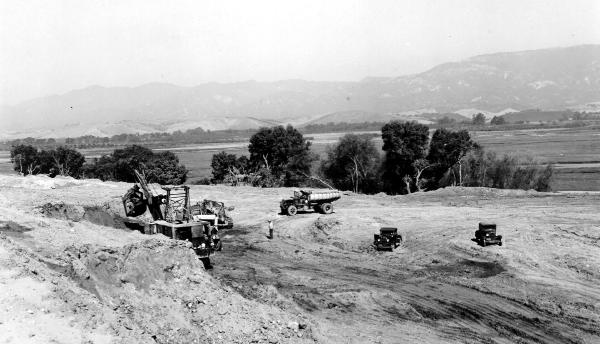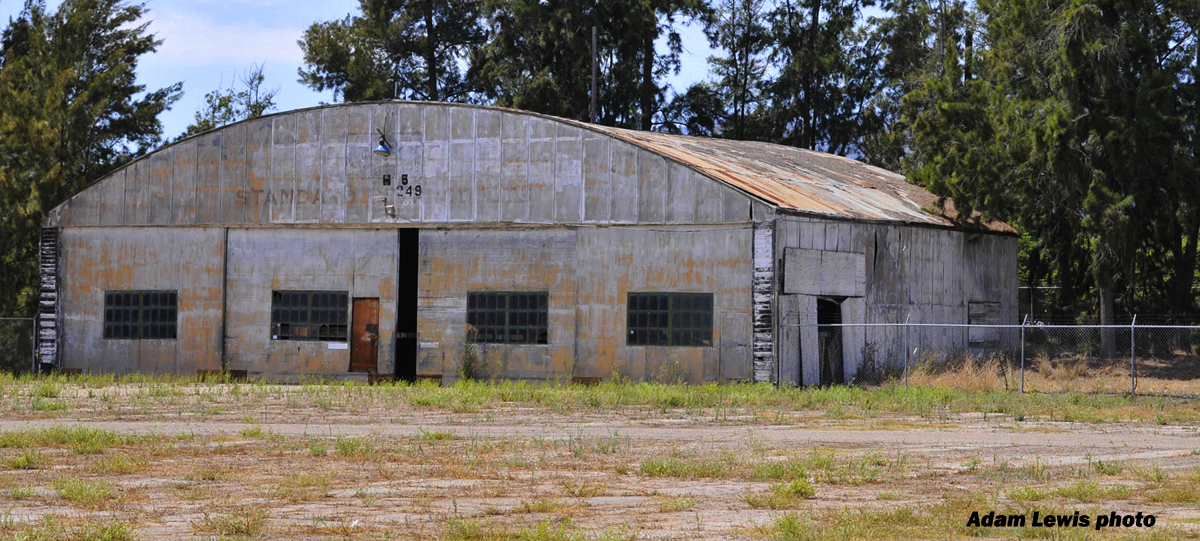By Tom Modugno of Goleta History
If you drive down Fairview by the airport, just past McLeans Auto Body, make a right at Freeman St. and follow the signs to Fed Ex. Keep driving past Fed Ex and you will drive right into these two historic hangars.
They’re easily overlooked, but have sat here proudly since the early 1930’s, and were used continuously until recently.
They came to our attention recently thanks to a news item, announcing their pending demolition. After doing some research, we found the article is misleading, and that the hangars in question are actually older than World War II. These are the genesis of today’s airport.
The first airplane ever spotted flying over Goleta was a rickety flying machine flown by this man, Lincoln Beachey. Beachey was a world famous “Barnstormer”, a pioneer American aviator who got rich and famous from flying exhibitions where he performed aerial stunts. His accomplishments are many, including being the first person to fly an airplane over Niagara Falls, inventing figure eights and the vertical drop, racing a train, letting his wheels touch the top of a moving train as he passed above, and he set many aviation records.
He did all these crazy things wearing a business suit and flying in a plane that was described as looking like “a beat-up orange crate.” He was performing at an Air Circus in Hope Ranch when he flew through the Goleta Valley as far as Ellwood Canyon, then returned to do a loop to loop and crashed into an oak tree at Laguna Blanca! He survived that crash, but died a year later when he crashed and drowned in the San Francisco Bay.
The next planes to fly over Goleta were retired war planes, being used to spot forest fires. In 1920, a fleet of these planes set up a temporary airfield south of Hollister Avenue, between Storke and Los Carneros.
The ground that close to the slough proved to be too soggy to make a functional landing strip, and the fragile planes were prone to flip when touching down. The site was soon abandoned.
In 1928, Royce Stetson and Gordon Sackett landed an airplane in a cow pasture behind St. Raphael’s church, which at that time was on the corner of Hollister and Fairview Ave. They leased that land and set up a flight school right there. The aviators enlisted the help of some county employees to scrape away the willows and brush, creating a 3,000 foot air strip. That first airstrip marked the beginning of what was to become the Santa Barbara Municipal Airport.
There was one other air strip in Santa Barbara at the time, operated by this man, Earl Ovington. It was near the Samarkand Hills and called the Casa Loma airfield, but it was regarded by many fliers as too dangerous to use.
In 1930 a test pilot from the General Western Aircraft Corporation inspected the new Goleta Airfield and the company decided to move it’s factory from Burbank to Goleta. In 1931 the City Council voted to terminate Ovington’s permit to operate the airport at Samarkand, and Frederick Stearns built two hangars at the Goleta airfield.
He also built a two story administration terminal between the hangars. The access road came in from Hollister Avenue to the north.
And there they sit, to this day.
General Western began producing “Meteor” airplanes, reportedly the first plane to have a metal rather than wooden propeller. Several “Meteors” were built there, but General Western soon ran into financial problems, and in 1932 shut down. The photo above is the General Western workforce in late 1931, with one of the hangars and a small terminal in the background.
Soon after the demise of General Western, Stearns took over operations. He added and paved more runways, installed radio equipment and established Santa Barbara Airways in 1932. The first passengers boarded planes from Pacific Seaboard Airlines.
On October 1st, 1936, United Airlines started daily service into Santa Barbara, and more than 1,000 citizens were on hand to welcome the first ten passenger Boeing to land in Goleta.
It was quite an event. Look at all the folks packed onto the old terminal, trying to get a better view.
Several other flying machines were on display for the public to get a close look at.
This shot from another angle show the size of the event. Also, is that a large inflated man floating above the scene? Some kind of an advertisement?
The ten passenger Boeing Airliner, state of the art commercial aircraft at the time.
Military and civilian officials gathered around the celebrated aircraft, with a microphone set up to address the huge crowd.
As air travel became more popular, so did the Santa Barbara airport. This great postcard from 1936 shows the two hangars in their heyday.
The location was still technically a slough, however, and when a good rainy season came, Mother Nature had her way. Looks like Lockheed took advantage of the conditions to break out one of their early sea planes?
The two hangars at the Santa Barbara airport were used for lots of publicity campaigns.
This one was a promotion for a movie at the Fox Arlington theater. That’s the owner of the hangars at the time, Burt Bundy, on the left, with an usher and the manager of the theater.
In 1938 a nationwide campaign called National Air Mail Week was launched in an effort to help the airline companies and to promote air mail service. Activities were planned across the United States and the goal of the organizers was to get each citizen to mail or receive an air mail letter during the week-long celebration. Famous aviator Bessie Owen flew a bag of mail from Goleta to Ventucopa in honor of the campaign.
Yeast tycoon, philanthropist and Santa Barbara mayor Max Fleischmann used the Santa Barbara airport for his private plane. This is a good shot of one of the hangars and the terminal.
Aviation legend Amelia Earhart at the two hangars with an early Lockheed aircraft.
The two hangars as a busy commercial airport in the late 1930’s.
An aerial view of the airport and some of the slough in 1938. Looks like the runway became the slough….
Circled are the two hangars and the intersection of Hollister and Fairview. Check out Goleta in 1938! A whole bunch of nothing but agriculture.
Looks like a billboard across Hollister Avenue? That’s where the Airport Drive In would later be.
In 1939 the Santa Barbara Chamber of Commerce recommended the site for a municipal airport should be the Goleta Slough. After much political wrangling, the real estate was secured along with federal grants to help with the cost. This is a good shot of the administration terminal that was demolished in the mid 1970’s.
By 1941, the Army Corps of Engineers began the huge job of filling in the slough with dirt from Mescaltitlan Island. With the advent of World War II, the construction was placed on high priority. The Marines moved in and construction was going on 24 hours a day.

Initially, the hangars were used as barracks and mess hall, until bigger facilities were constructed.
In this photo of Goleta in 1943, the two hangars can be seen tucked off in the corner of the completed air base.
This photo shows what a busy place it was around and behind the two hangars in 1944.
As you can see, the Marines built a lot of new hangars. This made the original two hangars somewhat outdated, but they continued to be used, despite their age.
After the war ended and the Marines left, the airfield in Goleta became the Santa Barbara Airport. By 1954, it had blossomed into a busy commercial airport. And it all started in the upper right corner of this photo, the two little seeds that started it all…….
The original two hangars, by this time across the street from the new Airport Drive-In Theater, and in 1954 they continued to be useful to the airport.
In fact, they continued to be used by the airport until just recently, when they were deemed unsafe and condemned.
Tom Smothermon put this nice comparison together of the hangars, yesterday and today.
If these two hangars could talk, they’d have a lot of stories to tell. They’ve seen a lot of changes in Goleta, and in aviation. From bi-planes to Lear jets, they have been participants in history every step of the way.
If you look closely, different company logos can still be seen painted on the buildings.
The old hangars are in a serious state of decay and if nothing is done, they will soon collapse.
Seems like an ideal location for an aviation museum to us, especially since Santa Barbara and Goleta have played such a large part in the history of aviation. Much more than we can mention on this short page. Hopefully the powers that be will reconsider their plans for demolition.
There are a couple of groups that are hoping to save the hangars in their original historic location, restore them and give them a new purpose, sharing the history of aviation with future generations. This will be a huge and expensive task, but it needs to be done. If you would like to be involved, contact us here.
Also, please send a letter to the Santa Barbara City Council, asking them to work to preserve these historic two hangars, since it is in their jurisdiction-
SBCityCouncil@SantaBarbaraCA.gov


















































